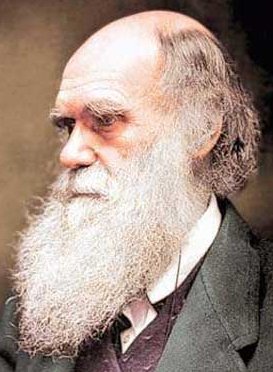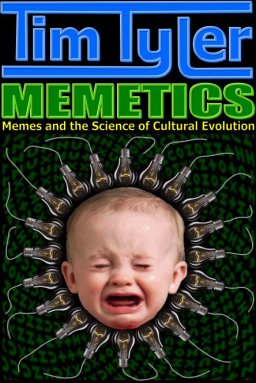The evolution of culture in a nutshell
The basic idea of cultural evolution
 The idea that human culture evolves is an old one. In The Origin of Species, Charles Darwin (1859) explained his idea of descent with modification in the animal and plant kingdoms by using an analogy with the way languages change and evolve over time. Languages show a branching tree-like structure - with some languages being obvious descendants of other ones. This is very similar to the phylogenetic trees of organic evolution. In the absence of detailed information about how inheritance took place, Darwin typically mixed the concepts of cultural and organic evolution together. In 1871, he wrote:
The idea that human culture evolves is an old one. In The Origin of Species, Charles Darwin (1859) explained his idea of descent with modification in the animal and plant kingdoms by using an analogy with the way languages change and evolve over time. Languages show a branching tree-like structure - with some languages being obvious descendants of other ones. This is very similar to the phylogenetic trees of organic evolution. In the absence of detailed information about how inheritance took place, Darwin typically mixed the concepts of cultural and organic evolution together. In 1871, he wrote:The survival or preservation of certain favoured words in the struggle for existence is natural selection.
Looking back from our current vantage point, Darwin appears to be well ahead of his time in terms of his understanding of cultural evolution.
There are similarities and differences between cultural and organic evolution. Unfortunately, these days the similarities have become rarely-mentioned - and cultural evolution has become an extremely neglected idea. For example, it is often not mentioned in evolution textbooks at all.
However, it is fairly self-evident that some traits of organisms persist down the generations without being coded for in DNA. Speaking a particular language is passed from one generation to the next - but the words of the language are not stored in genes. Surnames are passed down the paternal line. Religion is passed from parent to offspring. Circumcision, body-piercings, hair styles and beards are also passed faithfully down the generations in some cultures. These things are all culturally inherited. Variation of such traits is also common - as are differences in their copying rates and the rate at which they are lost.
The case for cultural evolution
The basic case for cultural evolution is relatively simple - cultural change is evolution - according to most modern definitions of the term "evolution". Here is the definition of Strickberger (1996) - in his textbook on evolution:Biological evolution entails inherited changes in populations of organisms, over a period of time, that lead to differences among them.
Notice that it does not say that inheritance must take place via DNA. If circumcised fathers are more likely to circumcise their sons, that is evidently a form of inheritance - but it is not mediated by DNA. The trait is passed on in some other way. Strickberger (1996) goes on to put the case for cultural inheritance concisely:
In short, humans have two unique hereditary systems. One is the genetic system that transfers biological information from biological parent to offspring in the form of genes and chromosomes. The other is the extragenetic system that transfers cultural information from speaker to listener, from writer to reader, from performer to spectator, and forms our cultural heritage.
That brings us onto the topic of the two primary inheritance channels of our species:
Dual inheritance theory
The idea that humans have two main inheritance systems is commonly known as Dual Inheritance Theory (DIT). The idea is that humans transmit information down the generations primarily via nucleic acids and human culture - and that other forms of inheritance are relatively insignificant. Dual Inheritance Theory is not yet widely appreciated - but it is of substantial importance to understanding the evolution of humans, the dynamics of the modern world, and what is most likely to happen in the future.Shared underlying principles
There have been a number of efforts to identify common principles of cultural and organic evolution. They both exhibit:- Heritable information - which persists for extended periods, allowing transmission down the generations;
- Imperfect copying processes - resulting in variation between the copies;
- Differential reproductive success - some copies persist better than others.


 Wheel evolution illustrates inheritance, variation and cumulative adaptation.
Wheel evolution illustrates inheritance, variation and cumulative adaptation.Cosmetic differences
However, there are also some differences between cultural and organic evolution. Some of the prominent examples:- Directed mutations - in organic evolution, mutations are usually considered to be undirected - and so do not systematically lead towards improvements. However, in cultural evolution mutations are sometimes highly directed. They can be made using induction, deduction, and Occam's razor - the full toolbox of intelligent design.
- Lamarckian inheritance - among organic organisms, it is rare for modifications of the phenotype to be inherited and transmitted to the next generation. However, in cultural evolution, such things are fairly common. If someone sprinkles cinnamon on the muffins - and the guests seem to like it - the next time it might be incorporated into the recipe and baked in.
Family trees
In organic evolution, lineages can be represented using family trees. The same is possible in cultural evolution. Language family tree.
Language family tree.These relationships between languages were known back in the 1850s - before Darwin wrote The Origin. Darwin actually used the descent with modification of languages to explain his theory of organic evolution. Back then, cultural evolution was more widely recognised as being correct than organic evolution.
Symbiosis
 The most powerful, obvious and straightforward way of modelling culture is as symbiotic organisms. Many will be familiar with the idea that wrist watches and wireless headsets can usefully be thought of as signs of the human symbiosis with technology. That is one manifestation of the symbiosis between humans and culture. There is an existing framework in biology for modelling symbiosis, and it works well when applied to human culture. Symbiotic relationships are usually classified as follows:
The most powerful, obvious and straightforward way of modelling culture is as symbiotic organisms. Many will be familiar with the idea that wrist watches and wireless headsets can usefully be thought of as signs of the human symbiosis with technology. That is one manifestation of the symbiosis between humans and culture. There is an existing framework in biology for modelling symbiosis, and it works well when applied to human culture. Symbiotic relationships are usually classified as follows:- Mutualism - Mutually beneficial relationships;
- Parasitism - One-sided relationships;
- Commensalism - Neither beneficial nor harmful.
Epidemiology
 Cultural phenomena exhibit transmission between individuals, and sometimes these reach epidemic proportions. Cultural entities have a certain level of contagiousness, and if this is below hat is known as the epidemic threshold. This threshold acts as a kind of tipping point. If you are below it, not very much happens - but above it, there is an explosion of activity, somewhat like a fission reaction, resulting in a cultural epidemic.
Cultural phenomena exhibit transmission between individuals, and sometimes these reach epidemic proportions. Cultural entities have a certain level of contagiousness, and if this is below hat is known as the epidemic threshold. This threshold acts as a kind of tipping point. If you are below it, not very much happens - but above it, there is an explosion of activity, somewhat like a fission reaction, resulting in a cultural epidemic.Model drawn from epidemiology treat culture as a symbiotic phenomenon. They are useful when explaining how news, fads, crazes and fashions spread through society.
Resource limitation
 Resource limitation is one of the key concepts in evolutionary biology. The idea went mainstream with Thomas Malthus and his 1798 work: "An Essay on the Principle of Population". Malthus's essay went on to inspire both Darwin and Wallace to create their theories of evolution.
Resource limitation is one of the key concepts in evolutionary biology. The idea went mainstream with Thomas Malthus and his 1798 work: "An Essay on the Principle of Population". Malthus's essay went on to inspire both Darwin and Wallace to create their theories of evolution.The idea is that populations of organisms have the ability and inclination to increase in size exponentially and tend to expand rapidly - up to the limits permitted by the available food supply. However, resources are typically much more limited. After a while expanding populations tend to reach a point where further growth is no longer supported by the available resources. At that stage, births must be balanced by deaths.
Darwin (1859) gave Chapter Three of "On The Origin of Species" the title "The Struggle for Existence". The chapter worked through the consequences of Malthus's insight. The idea is also highly significant in the realm of human culture. Cultural entities face a struggle for existence too. For them, the primary limited resource is human brains. Most reproduction of cultural entities currently either takes place in human brains - or is triggered by the action of human brains. Those brains have limited storage space for cultural items. So there is competition between them to find their way into brains.
Adaptive culture
 We can be pretty sure that culture was adaptive among our ancestors since we have adaptations oriented towards spreading culture - our incessant babbling, our ultrasociality and the huge cultural libraries we carry around everywhere on our shoulders. It seems likely that culture is adaptive today - since culture-free humans are like primitive cave men, and most such creatures would not do very well in the modern world.
We can be pretty sure that culture was adaptive among our ancestors since we have adaptations oriented towards spreading culture - our incessant babbling, our ultrasociality and the huge cultural libraries we carry around everywhere on our shoulders. It seems likely that culture is adaptive today - since culture-free humans are like primitive cave men, and most such creatures would not do very well in the modern world.To summarise, culture allows individuals to:
- Reduce costly errors associated with trial-and-error learning;
- Quickly acquire useful ideas much more rapidly than trial-and-error learning would permit;
- Acquire better quality ideas than they would have been likely to produce themselves.
Internet culture
 As time has passed, human culture has expanded and diversified. This has resulted in many more examples of cultural evolution for scientists to study. Where once chain letters, urban legends, languages and scientific theories were used to provide the evidence supporting the idea of cultural evolution, now there is a plethora of new types of digital media on the internet - audio, video, text - all widely available to anyone who cares to look. There is also a lot more in the way of tracking and monitoring tools available. If you want to know when a particular computer virus mutated, such details are often archived and can be tracked down. If you want to know whether The Beatles were ever more popular than Jesus, that too can be investigated.
As time has passed, human culture has expanded and diversified. This has resulted in many more examples of cultural evolution for scientists to study. Where once chain letters, urban legends, languages and scientific theories were used to provide the evidence supporting the idea of cultural evolution, now there is a plethora of new types of digital media on the internet - audio, video, text - all widely available to anyone who cares to look. There is also a lot more in the way of tracking and monitoring tools available. If you want to know when a particular computer virus mutated, such details are often archived and can be tracked down. If you want to know whether The Beatles were ever more popular than Jesus, that too can be investigated.Going digital
 One issue that seems to hinder understanding of the idea of cultural evolution is low-fidelity transmission. Organic inheritance mostly uses digital high-fidelity transmission - but sometimes cultural information is low-fidelity, or is represented in partly-analog systems. When present, high mutation rates can destroy the accumulation of culture, limit the quantity of culture that can exist, and result in fewer cultural adaptations. Some people have complained that this weakens the analogy between organic inheritance and cultural inheritance.
One issue that seems to hinder understanding of the idea of cultural evolution is low-fidelity transmission. Organic inheritance mostly uses digital high-fidelity transmission - but sometimes cultural information is low-fidelity, or is represented in partly-analog systems. When present, high mutation rates can destroy the accumulation of culture, limit the quantity of culture that can exist, and result in fewer cultural adaptations. Some people have complained that this weakens the analogy between organic inheritance and cultural inheritance.However, in modern times, we have seen a gradual switch to digital forms of cultural transmission and storage. This digital revolution has resulted in a greater volume of culture, a closer correspondence between cultural and organic inheritance, and much more evidence of cultural evolution. The objection that cultural evolution suffers from low-fidelity transmission was a pretty feeble one in the first place. However, it is becoming increasingly irrelevant - as culture is digitised and gains access to high-fidelity storage and transmission media.
Rise of the idea
The idea that culture evolves dates back to Darwin's era. As time has passed, academic and popular scientific publications supporting cultural evolution have gradually accumulated. Some of the better-known supporters of the idea include: Richard Dawkins, Daniel Dennett, Douglas Hofstadter, Susan Blackmore, David Hull, Rob Boyd, Peter Richerson, David Deutsch and Ed Wilson. These days there is a big mountain of supporting evidence. That culture evolves is a fact, much as the idea that the organic world evolves is a fact. If anything, we have better evidence for cultural evolution - since it happens so much more rapidly - and so we can see it talking place more clearly.Controversy
Though it should be obvious that culture evolves, exactly how it evolves has been a controversial issue. Most theories of cultural evolution are based in some way on Darwin's theory of evolution of by natural selection. However, to many it is not completely obvious which parts of Darwin's theory are applicable, and which are not. The issue has caused a substantial quantity of difficulties and controversy.Significance
Cultural evolution is the single most important idea for understanding cultural change. In the organic world, evolution forms the central organising principle - the basic concept which practically everything else is explained in terms of. Cultural evolution has a similar significance for explaining human culture.Most of the change in human civilisation is cultural. Organic evolution happens on a much slower timescale, and often happens too slowly for us to observe - so cultural evolution explains most of the significant recent human changes.
Cultural evolution is ancient, going back beyond our split from chimpanzees. It affected the whole of the last 7 million years of evolution, with increasing intensity as time passed. It is not possible to understand human evolution without having an understanding of cultural evolution. Many have attempted to understand human evolution without understanding cultural evolution - but their efforts are uniformly hopeless.
Cultural evolution is the key science for understanding change in human civilisation at the present time. Similarly, it is key to understanding where we are going. Humanity badly needs to understand how culture changes so that we can steer it in desirable directions. Undesirable culture can result in stagnation, wars, revolutions and genocide.
Neglect
Though the idea of cultural evolution has been around for a very long while, its penetration into the scientific world is poor. Though the basic ideas seem fairly simple and obvious, a series of problems and setbacks have hampered its development. The problems have included mistakes by the founders, resistance from established academics in adjacent fields, and distaste for the whole idea of a Darwinian explanation of human culture. The result is that the field has suffered from slow development, a bad reputation, poor funding and status - and has been widely neglected.The neglect of cultural evolution by social scientists has been a pretty major disaster for the scientific enterprise. Evolutionary theory is central to biology, and cultural evolution is central to understanding human culture. Without cultural evolution the study of culture remains stuck a pre-Darwinian era - in much the same way that the study of organic systems lacked a central organising principle in the days before Darwin. Cultural evolution has the potential to unite the social sciences. However, social science has never really got into Darwin. For over a hundred years, most social scientists have refused to face the Darwinian music - preferring instead to put their fingers in their ears and sing their own "la-la" song. This has kept the social sciences stuck in a pre-Darwinian era. As a result the social sciences are highly balkanised - with experts in adjacent fields lacking common principles and a unifying theory. This situation is intolerable. It has got to stop.
Modern ascendance
Though cultural evolution has been neglected, it seems to be fairly clearly in the ascendant in the last couple of decades. The last decade in particular has been a fertile one for the study of cultural evolution, with hundreds of publications on the topic, and a lot of empirical research being performed. That human culture evolves has always been pretty self-evident, but there has also been a lot of work on non-human animals in the last decade. We know a lot more about the topic of cultural evolution now than we have ever done before.This material was adapted from chapter 2 of my Memetics book.










No comments:
Post a Comment